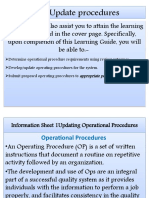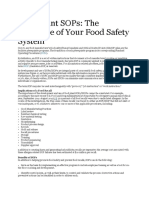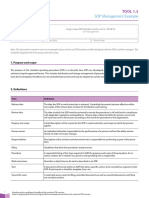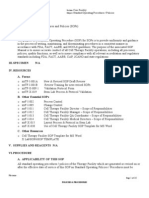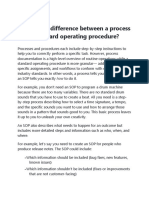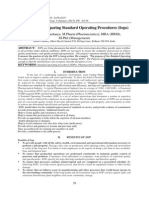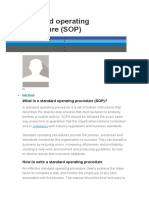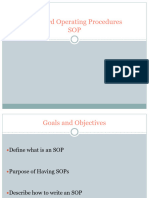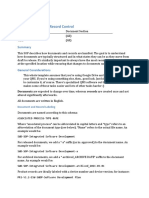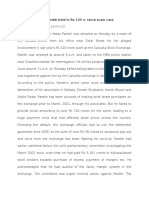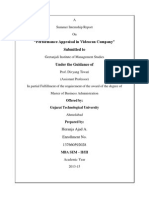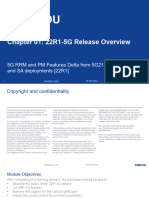Sop
Sop
Uploaded by
Nishad JoshiCopyright:
Available Formats
Sop
Sop
Uploaded by
Nishad JoshiOriginal Description:
Copyright
Available Formats
Share this document
Did you find this document useful?
Is this content inappropriate?
Copyright:
Available Formats
Sop
Sop
Uploaded by
Nishad JoshiCopyright:
Available Formats
As implied above, the initiative and further procedure for the preparation, implementation and
management of the documents is a procedure in itself which should be described. These SOPs should at
least mention:
who can or should make which type of SOP;
to whom proposals for a SOP should be submitted, and who adjudges the draft;
the procedure of approval;
who decides on the date of implementation, and who should be informed;
how revisions can be made or how a SOP can be withdrawn.
It should be established and recorded who is responsible for the proper distribution of the documents, the
filing and administration (e.g. of the original and further copies). Finally, it should be indicated how
frequently a valid SOP should be periodically evaluated (usually 2 years) and by whom. Only officially
issued copies may be used, only then the use of the proper instruction is guaranteed.
In the laboratory the procedure for the preparation of a SOP should be as follows:
The Head of Laboratory (HoL) charges a staff member of the laboratory to draft a SOP (or the HoL does
this himself or a staff member takes the initiative). In principle, the author is the person who will work
with the SOP, but he or she should always keep in mind that the SOP needs to be understood by others.
The author requests a new registration number from the SOP administrator or custodian (which in smaller
institutes or laboratories will often be the HoL, see 2.4). The administrator verifies if the SOP already
exists (or is drafted). If the SOP does not exist yet, the title and author are entered into the registration
system. Once the writing of a SOP is undertaken, the management must actively support this effort and
allow authors adequate preparation time.
In case of methodic or apparatus SOPs the author asks one or more qualified colleagues to try out the
SOP. In case of execution procedures for investigations or protocols, the project leader or HoL could do
the testing. In this phase the wording of the SOP is fine-tuned. When the test is passed, the SOP is
submitted to the SOP administrator for acceptance. Revisions of SOPs follow the same procedure.
2.3 Preparation of SOPs
The make-up of the documents should meet a minimum number of requirements:
1. Each page should have a heading and/or footing mentioning:
a. date of approval and/or version number;
b. a unique title (abbreviated if desired);
c. the number of the SOP (preferably with category);
d. page number and total number of pages of the SOP.
e. the heading (or only the logo) of originals should preferably be printed in another colour than black.
Categories can be denoted with a letter or combination of letters, e.g.:
- F for fundamental SOP
- A or APP for apparatus SOP
- M or METH for analytical method SOP
- P or PROJ for procedure to carry out a special investigation (project)
- PROT for a protocol describing a sequence of actions or operations
- ORG for an organizational document
- PERS for describing personnel matters
- RF for registration form (e.g. chemicals, samples)
- WS for worksheet (related to analytical procedures)
From this description it would seem that the preparation and administration of a SOP and other
quality assurance documentation is an onerous job. However, once the draft is made, with the
use of word processors and a simple distribution scheme of persons and departments involved,
the task can be considerably eased.
A model for a simple preparation and distribution scheme is given in Figure 2-1. This is a
relation matrix which can not only be used for the laboratory but for any department or a whole
institute. In this matrix (which can be given the status of a SOP) can be indicated all persons or
departments that are involved with the subject as well as the kind of their involvement. This can
be indicated in the scheme with an involvement code. Some of the most usual involvements are
(the number can be used as the code):
1. Taking initiative for drafting
2. Drafting the document
3. Verifying
4. Authorizing
5. Implementing/using
6. Copy for information
7. Checking implementation
8. Archiving
There is a multitude of valid approaches for distribution of SOPs but there must always be a
mechanism for informing potential users that a new SOP has been written or that an existing
SOP has been revised or withdrawn.
It is worthwhile to set up a good filing system for all documents right at the outset. This will
spare much inconvenience, confusion and embarrassment, not only in internal use but also with
respect to the institute's management, authorities, clients and, if applicable, inspectors of the
accreditation body.
The administrator responsible for distribution and archiving SOPs may differ per institute. In
large institutes or institutes with an accredited laboratory this will be the Quality Assurance
Officer, otherwise this may be an officer of the department of Personnel & Organization or still
someone else. In non-accredited laboratories the administration can most conveniently be done
by the head of laboratory or his deputy. The administration may be done in a logbook, by means
of a card system or, more conveniently, with a computerized database such as PerfectView or
Cardbox. Suspending files are very useful for keeping originals, copies and other information of
documents. The most logic system seems to make an appropriate grouping into categories and
a master index for easy retrieval. It is most convenient to keep these files at a central place such
as the office of the head of laboratory. Naturally, this does not apply to working documents that
obviously are used at the work place in the laboratory, e.g., instrument logbooks, operation
instruction manuals and laboratory notebooks.
The data which should be stored per document are:
- SOP number
- version number
- date of issue
- date of expiry
- title
- author
- status (title submitted; being drafted; draft ready; issued)
- department of holders/users
- names of holders
- number of copies per holder if this is more than one
- registration number of SOPs to which reference is made
- historical data (dates of previous issues)
The SOP administrator keeps at least two copies of each SOP; one for the historical and one for
the back-up file. This also applies to revised versions. Superseded versions should be collected
and destroyed (except the copy for the historical file) to avoid confusion and unauthorized use.
Examples of various categories of SOPs will be given in the ensuing chapters. The contents of a
SOP for the administration and management of SOPs can be distilled from the above. An
example of the basic format is given as Model F 002.
You might also like
- SOP On Writing SOPsDocument3 pagesSOP On Writing SOPsAdriapratama Munardi100% (1)
- Standard Operating Procedures ManualDocument11 pagesStandard Operating Procedures ManualPeter Mulila100% (2)
- HR Standard Operating ProceduresDocument10 pagesHR Standard Operating Proceduresgayathri narayana100% (3)
- 2 Standard Operating ProceduresDocument9 pages2 Standard Operating ProceduresAtri ChakrabortyNo ratings yet
- SOPs How To WriteDocument10 pagesSOPs How To WritemrdeniceNo ratings yet
- Standard Operating Procedure: Presented by - Amey Deshpande Guided BY - R V KshirsagarDocument22 pagesStandard Operating Procedure: Presented by - Amey Deshpande Guided BY - R V Kshirsagaramey_dpd100% (1)
- Swift 1Document47 pagesSwift 1Ahmad Fauzie Ibrahim Ismail100% (1)
- 2 Standard Operating ProceduresDocument12 pages2 Standard Operating ProceduresGoodson MitochiNo ratings yet
- WWW Fao Org Docrep W7295e W7295e04 HTM TopOfPageDocument16 pagesWWW Fao Org Docrep W7295e W7295e04 HTM TopOfPageKyaw KyawNo ratings yet
- Standard Operating Procedures QADocument28 pagesStandard Operating Procedures QABhavyaNo ratings yet
- A Standard Operating ProcedureDocument4 pagesA Standard Operating ProcedureSanjayNo ratings yet
- Presentation 2Document9 pagesPresentation 2Eliyaas Wakjira HirphaNo ratings yet
- Food Plant SOPsDocument4 pagesFood Plant SOPsRia UtamiNo ratings yet
- CC Into Sa LaDocument9 pagesCC Into Sa LaPavan ReddyNo ratings yet
- Title: Standard Operating Procedure (Sop) Prepared By: Group 2 ContentsDocument6 pagesTitle: Standard Operating Procedure (Sop) Prepared By: Group 2 ContentsNeznej AglitNo ratings yet
- Blueprint For Clinical Research Sops FINALDocument41 pagesBlueprint For Clinical Research Sops FINALZeeshan Zafar0% (1)
- SOP Template - 061819Document3 pagesSOP Template - 061819DennisDonovanNo ratings yet
- How To Write A Standard Operating Procedure V 1Document3 pagesHow To Write A Standard Operating Procedure V 1Mihai IonitaNo ratings yet
- Guidance For Preparing Standard Operating Procedures (Sops) : Epa Qa/G-6Document60 pagesGuidance For Preparing Standard Operating Procedures (Sops) : Epa Qa/G-6rai_khan_1No ratings yet
- TC - 1.3. SOP Management Example - 21 06 2021Document8 pagesTC - 1.3. SOP Management Example - 21 06 2021adi.darm2024No ratings yet
- Documentation - 1Document17 pagesDocumentation - 1Lovely JimsonNo ratings yet
- Micro Link TVET College: Learning Guide # 07Document7 pagesMicro Link TVET College: Learning Guide # 07cherkos weldayNo ratings yet
- Ethiopian TVET-System: Update and Document Operational Procedures DateDocument11 pagesEthiopian TVET-System: Update and Document Operational Procedures Datebiruk mollaNo ratings yet
- 1-Introduction To Standard Operating ProceduresDocument2 pages1-Introduction To Standard Operating Proceduresfhreank100% (1)
- The Basics of Document Control in The LaboratoryDocument37 pagesThe Basics of Document Control in The Laboratoryoptical420No ratings yet
- Planning and Preparing Standard Operating ProcedureDocument17 pagesPlanning and Preparing Standard Operating ProcedureTin TinNo ratings yet
- BST College: Learning GuideDocument8 pagesBST College: Learning GuideEliyaas Wakjira HirphaNo ratings yet
- Document Control 4Document15 pagesDocument Control 4Puteri Sulima HassanNo ratings yet
- Standard Operating ProceduresDocument11 pagesStandard Operating ProceduresAlok Kumar100% (3)
- Standard Operating ProceduresDocument2 pagesStandard Operating ProceduresWerner SchrammelNo ratings yet
- Lesson 1: Scale Up Manufacturing: A. Bill of Materials (BOM)Document53 pagesLesson 1: Scale Up Manufacturing: A. Bill of Materials (BOM)Johmarie TanNo ratings yet
- Making An SOPDocument11 pagesMaking An SOPByaruhanga EmmanuelNo ratings yet
- Standard Operating ProceduresDocument12 pagesStandard Operating ProceduresDudipala Vijaya Bhaskar ReddyNo ratings yet
- Standard Operating ProceduresDocument11 pagesStandard Operating ProceduresJayant Kumar JhaNo ratings yet
- Standard Operating Procedure (Sop) : Presented by GovindDocument22 pagesStandard Operating Procedure (Sop) : Presented by GovindHarigovind GoliNo ratings yet
- Sop 5Document12 pagesSop 5Naveed AkhterNo ratings yet
- Guidance For Preparing Standard Operating Procedures (Sops)Document8 pagesGuidance For Preparing Standard Operating Procedures (Sops)IOSR Journal of PharmacyNo ratings yet
- Writing Sops and TemplatesDocument10 pagesWriting Sops and TemplatesCristiNo ratings yet
- What Is A Standard Operating Procedure (SOP) ?Document7 pagesWhat Is A Standard Operating Procedure (SOP) ?عماد جوادNo ratings yet
- Eng 3 - English 3 (Textbook) ADocument107 pagesEng 3 - English 3 (Textbook) ARonanda SaputraNo ratings yet
- 11 - Standard Operating ProceduresDocument12 pages11 - Standard Operating Proceduresreddyrani928No ratings yet
- How To Write SOPDocument4 pagesHow To Write SOPRYENA111No ratings yet
- SopDocument3 pagesSopmrchilliciousNo ratings yet
- How To Write A Standard Operating ProcedureDocument9 pagesHow To Write A Standard Operating ProcedurerupeshghadiNo ratings yet
- Template Master SOP 0 0Document13 pagesTemplate Master SOP 0 0withraviNo ratings yet
- SOP Word TemplateDocument4 pagesSOP Word TemplateViko trah dewangga100% (1)
- System Development Life CycleDocument7 pagesSystem Development Life Cyclevictory IsaacNo ratings yet
- Guidelines On The Preparation Maintenance and Control of DocumentationDocument17 pagesGuidelines On The Preparation Maintenance and Control of DocumentationNani JNo ratings yet
- Hazard Operability StudiesDocument8 pagesHazard Operability StudiesPendi Adi MertaNo ratings yet
- SOP Basic TemplateDocument5 pagesSOP Basic TemplateJitendra Kumar BiswasNo ratings yet
- ISO 14001 DocumentationDocument7 pagesISO 14001 Documentationzahidned100% (1)
- Sop Document Record ControlDocument6 pagesSop Document Record ControlNur Mohammed MunshiNo ratings yet
- Writing Bulletproof Sops: Best Practices For Life Sciences CompaniesDocument5 pagesWriting Bulletproof Sops: Best Practices For Life Sciences CompaniesАндрейNo ratings yet
- Guidelines for Organization of Working Papers on Operational AuditsFrom EverandGuidelines for Organization of Working Papers on Operational AuditsNo ratings yet
- Guidelines to make your own SOP (Standard Operating Procedure)): 1, #1From EverandGuidelines to make your own SOP (Standard Operating Procedure)): 1, #1No ratings yet
- Date Day Month Year Open High Low CloseDocument5 pagesDate Day Month Year Open High Low CloseNishad JoshiNo ratings yet
- Issue Tracker TemplateDocument10 pagesIssue Tracker TemplateNishad JoshiNo ratings yet
- Ketan Parekh Held in Rs 120 CR Stock Scam CaseDocument3 pagesKetan Parekh Held in Rs 120 CR Stock Scam CaseNishad JoshiNo ratings yet
- The 1992 Scam: Brokerage FirmsDocument4 pagesThe 1992 Scam: Brokerage FirmsNishad JoshiNo ratings yet
- E Receipt For State Bank Collect PaymentDocument2 pagesE Receipt For State Bank Collect PaymentNishad JoshiNo ratings yet
- December 18, 2009 - UPDATED 09:14 IST: The Crash That Shook The NationDocument4 pagesDecember 18, 2009 - UPDATED 09:14 IST: The Crash That Shook The NationNishad JoshiNo ratings yet
- Isro - Written Test For The Post of Scientist/Engineer SC - ElectricalDocument3 pagesIsro - Written Test For The Post of Scientist/Engineer SC - ElectricalNishad JoshiNo ratings yet
- "Performance Appraisal in Videocon Company" Submitted To: Offered By: Gujarat Technological UniversityDocument7 pages"Performance Appraisal in Videocon Company" Submitted To: Offered By: Gujarat Technological UniversityNishad JoshiNo ratings yet
- "Performance Appraisal in Videocon Company" Submitted To: Offered By: Gujarat Technological UniversityDocument16 pages"Performance Appraisal in Videocon Company" Submitted To: Offered By: Gujarat Technological UniversityNishad JoshiNo ratings yet
- T & I System: Telecom, Instrumentation & Control SystemsDocument12 pagesT & I System: Telecom, Instrumentation & Control SystemsNishad JoshiNo ratings yet
- Leak Handling: Emergency Procedure For Handling Pipeline LeakagesDocument10 pagesLeak Handling: Emergency Procedure For Handling Pipeline LeakagesNishad JoshiNo ratings yet
- 09-Safety & First AidDocument14 pages09-Safety & First AidNishad JoshiNo ratings yet
- Keltbray Crude Oil and Gas LTDDocument1 pageKeltbray Crude Oil and Gas LTDNishad JoshiNo ratings yet
- Motivation LetterDocument1 pageMotivation Letterboshir_bd88% (17)
- GSM ArchitectureDocument442 pagesGSM ArchitecturePritam Kumar ChawlaNo ratings yet
- Linux Red HatDocument35 pagesLinux Red HatAkhilmpecNo ratings yet
- New Updated Fortinet Nse4 - fgt-6.0 Exam Dumps - 100% ValidDocument6 pagesNew Updated Fortinet Nse4 - fgt-6.0 Exam Dumps - 100% ValidExam dumpsNo ratings yet
- LG EnVX11K Service Manual 0430 (Cellular Phone)Document200 pagesLG EnVX11K Service Manual 0430 (Cellular Phone)MikeNo ratings yet
- SG DriverDocument18 pagesSG Driverhary123No ratings yet
- Azure Blob Storage DocumentationDocument21 pagesAzure Blob Storage Documentationanamik2100100% (1)
- Data Engineering CookbookDocument124 pagesData Engineering Cookbookfcomoraess100% (1)
- Mpls Lab 2 - Mpls VRF VpnsDocument13 pagesMpls Lab 2 - Mpls VRF VpnsSo ManiNo ratings yet
- Ec2051 QBDocument5 pagesEc2051 QBajayroy12No ratings yet
- ASR-901 L2 Switch NIP - V1 - Spur - I-HP-KDGT-ESC-0001 - KDGTKDGTESS074Document24 pagesASR-901 L2 Switch NIP - V1 - Spur - I-HP-KDGT-ESC-0001 - KDGTKDGTESS074ritu gaurNo ratings yet
- PC Configure Computer Center: September 7, 2012Document9 pagesPC Configure Computer Center: September 7, 2012Noel CastilloNo ratings yet
- ALU - BFD Session Down - RCA - TACDocument11 pagesALU - BFD Session Down - RCA - TACravi kantNo ratings yet
- Vm-741B Local Communication & Phase Marker ModuleDocument4 pagesVm-741B Local Communication & Phase Marker ModuleVan QuynhNo ratings yet
- Cyberlaws and SecurityDocument1 pageCyberlaws and Security17001009023 HINGULA BHAT100% (1)
- User Manual WINOXLR 3-6-14 ProductsDocument59 pagesUser Manual WINOXLR 3-6-14 ProductslotNo ratings yet
- GSM900 BN 10996 (B)Document4 pagesGSM900 BN 10996 (B)vaskoa1No ratings yet
- THN - Whitehorses - Whitebook - 31. Azure Application Gateway Connection - v3Document13 pagesTHN - Whitehorses - Whitebook - 31. Azure Application Gateway Connection - v3cristian080989No ratings yet
- Political Science Hand Written Notes PDFDocument77 pagesPolitical Science Hand Written Notes PDFAyaz HussainNo ratings yet
- Embedded Systems Engineering Lecture 08 (UART)Document28 pagesEmbedded Systems Engineering Lecture 08 (UART)Nushara WedasinghaNo ratings yet
- YBM 1200 ManualDocument31 pagesYBM 1200 Manualmartinaleguzzo100% (1)
- Ccna Lab ManualDocument83 pagesCcna Lab ManualsamuelNo ratings yet
- DWR-921 C3 FW Release Note - 20170823Document6 pagesDWR-921 C3 FW Release Note - 20170823Tomás PGNo ratings yet
- IoT Lesson PlanDocument2 pagesIoT Lesson PlanNaresh KumarNo ratings yet
- IPTV Overview - Part 1 - WWW - IpciscoDocument6 pagesIPTV Overview - Part 1 - WWW - IpciscoJesus RosalesNo ratings yet
- 35kV Deadbreak CapDocument2 pages35kV Deadbreak CapChetram Jared GeorgeNo ratings yet
- Netstat Command and Its UsageDocument10 pagesNetstat Command and Its Usageveera42No ratings yet
- 22R1-5G Release OverviewDocument22 pages22R1-5G Release OverviewkuldeepNo ratings yet
- Introduction of Kubernetes: Trang Nguyen PresentationDocument40 pagesIntroduction of Kubernetes: Trang Nguyen Presentationcontact dedydarNo ratings yet
- Lab 10 PDFDocument2 pagesLab 10 PDFamitmsh1995No ratings yet













